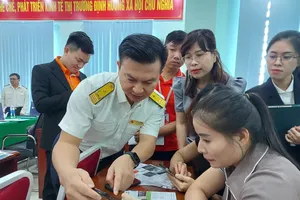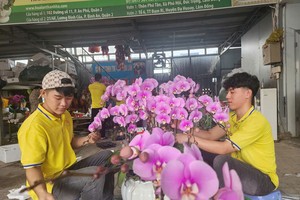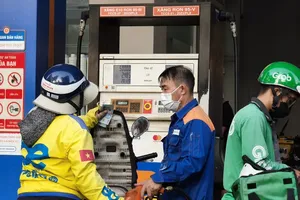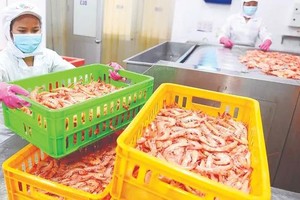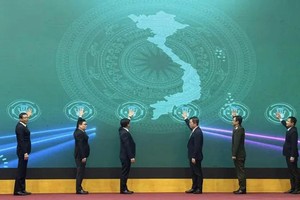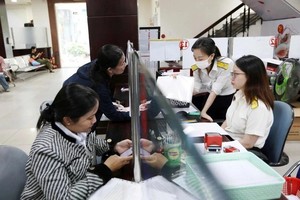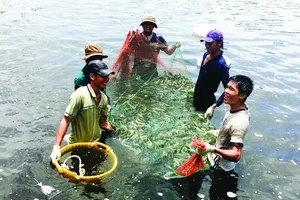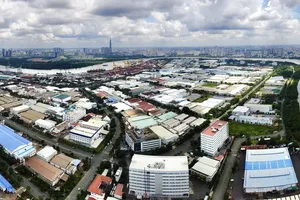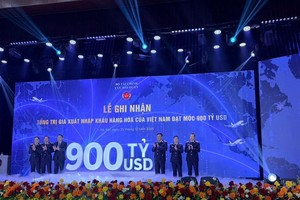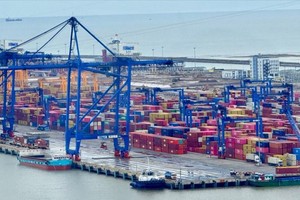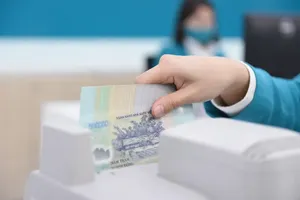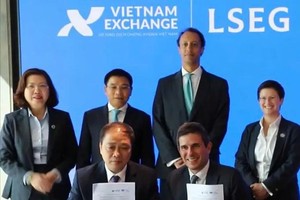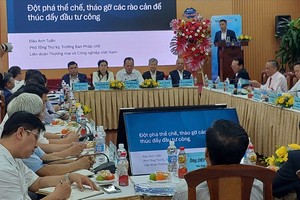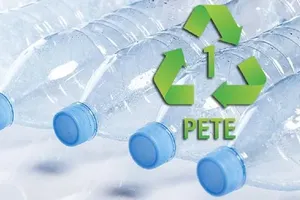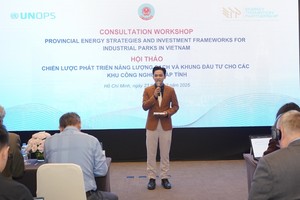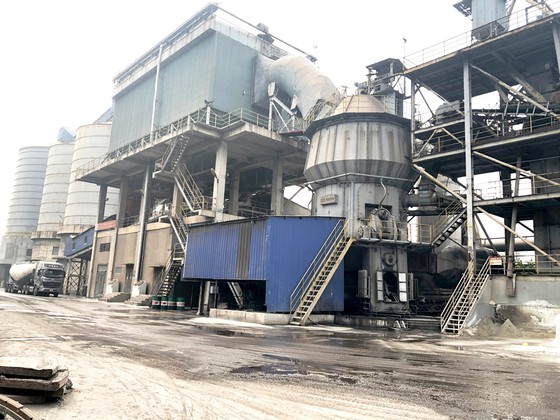 Hoa Phat Group's blast furnace slag recycling line. (Photo: SGGP)
Hoa Phat Group's blast furnace slag recycling line. (Photo: SGGP)
There are no exact statistics, but more and more Vietnamese enterprises are aware of the advantages of this circular principle and investing heavily in waste recycling, helping to prolong the value-added chain, reducing waste treatment costs, and protecting the environment.
More life cycle for waste
According to Mr. Tran Tuan Duong, CEO of Hoa Phat Group, the production of millions of tons of steel at its factory in Dung Quat generates a huge amount of heat. In order to not waste this source of heat, Hoa Phat invested in a plant with a capacity of up to 240MW to convert this huge amount of residual heat into input material for power generation. By doing that, Hoa Phat has been self-supplied up to 80 percent of the electricity needed for steel production and only needs to buy the remaining 20 percent. In addition, the company also promotes the recycling of blast furnace slag into construction materials. Fine blast furnace slag powder is a by-product of the production of iron and steel by closed blast furnace technology. Thanks to extremely fast cooling by high-pressure water, blast furnace slag is a very good active mineral additive for cement and concrete that has been used for a long time in the world, as well as in Vietnam. Producing blast furnace slag products not only helps Hoa Phat protect the environment but also creates a stable source of income for the unit.
Similarly, Mr. Fausto Tazzi, General Director of La Vie Co., Ltd., said that almost all of La Vie's product packaging is now 100 percent recyclable. Not only that, in early 2021, La Vie used water bottles made from recycled plastic (rPET) that meets food safety standards. The representative of this unit also affirmed that it always encourages domestic enterprises to invest in rPET production and is willing to buy qualified products to make product packaging for his company. Previously, in 2019, La Vie and Nestlé Vietnam joined hands with leading companies in the field of consumer goods and packaging to found the Packaging Recycling Organization Vietnam (PRO Vietnam).
There are no official statistics on the number of businesses that recycle waste in the production process, but according to Assoc. Prof. – Dr. Phung Chi Sy, Vietnam Association for Conservation of Nature and Environment, there are changes in thinking about waste management in many enterprises. Many enterprises have considered waste as a resource, an input material for a new production process. In agriculture, coir, straw, and rice husk discharged from agricultural production activities have become raw materials for making straw mushrooms and carpets. In industrial production, lots of product packaging made of paper and wood has been collected and recycled to create an extra life cycle for waste.
The polluters must pay
Vietnam is among the 20 countries with the highest amount of waste globally. Vietnam is ranked fourth in the world for discharging plastic waste into the environment, estimated at 1.8 million tons per year. However, the country is the world's second-largest importer of plastic scrap.
Not only plastic, but Vietnam also imports an average of about 10 million tons of scraps of all kinds every year. Especially in 2019, Vietnam had to import more than 18 million tons of scraps, including iron, steel, paper, and plastic. How ironic it is when Vietnam has to import waste for recycling and reuse, but domestically, an abundant source of recyclable materials is wasted and thrown away. Not to mention that it costs lots of money to treat this amount of waste.
To overcome the above shortcoming, the Law on Environmental Protection 2020, which took effect from January 1, 2022, has introduced regulations on the extended producer responsibility (EPR) to the disposal stage within a product life cycle. This means that manufacturers and importers must be responsible for recycling and treating waste in the correct proportions and specifications. This regulation is a solution to increase the domestic recycling rate and reduce the scrap import rate, thereby reducing plastic waste in the environment.
Agreeing with this regulation, Mr. Fausto Tazzi added that, to have an actually effective EPR mechanism, it is necessary to build a logistics chain for after-use packaging with the participation of all relevant parties, including manufacturers, retailers, consumers, waste collectors, and recyclers. Once this chain is well controlled, the quality of waste will be ensured. Thereby, after-use packaging can become a high-value raw material, which will continue to return to the production cycle instead of being discharged into the environment. Authorities need to create an equal environment for all parties in the EPR model, and these are necessary conditions for the EPR system to operate properly.
From the perspective of a management unit, Mr. Phan Tuan Hung, Director of the Legal Department under the Ministry of Natural Resources and Environment, assessed that EPR is an environmental policy that follows the principle of "polluters pay". This approach is effective in sharing the financial burden or part of the responsibility for solid waste management of local authorities with producers and importers. Although a few businesses have participated, with some pioneering units, it shows that everything is changing for the better.
More life cycle for waste
According to Mr. Tran Tuan Duong, CEO of Hoa Phat Group, the production of millions of tons of steel at its factory in Dung Quat generates a huge amount of heat. In order to not waste this source of heat, Hoa Phat invested in a plant with a capacity of up to 240MW to convert this huge amount of residual heat into input material for power generation. By doing that, Hoa Phat has been self-supplied up to 80 percent of the electricity needed for steel production and only needs to buy the remaining 20 percent. In addition, the company also promotes the recycling of blast furnace slag into construction materials. Fine blast furnace slag powder is a by-product of the production of iron and steel by closed blast furnace technology. Thanks to extremely fast cooling by high-pressure water, blast furnace slag is a very good active mineral additive for cement and concrete that has been used for a long time in the world, as well as in Vietnam. Producing blast furnace slag products not only helps Hoa Phat protect the environment but also creates a stable source of income for the unit.
Similarly, Mr. Fausto Tazzi, General Director of La Vie Co., Ltd., said that almost all of La Vie's product packaging is now 100 percent recyclable. Not only that, in early 2021, La Vie used water bottles made from recycled plastic (rPET) that meets food safety standards. The representative of this unit also affirmed that it always encourages domestic enterprises to invest in rPET production and is willing to buy qualified products to make product packaging for his company. Previously, in 2019, La Vie and Nestlé Vietnam joined hands with leading companies in the field of consumer goods and packaging to found the Packaging Recycling Organization Vietnam (PRO Vietnam).
There are no official statistics on the number of businesses that recycle waste in the production process, but according to Assoc. Prof. – Dr. Phung Chi Sy, Vietnam Association for Conservation of Nature and Environment, there are changes in thinking about waste management in many enterprises. Many enterprises have considered waste as a resource, an input material for a new production process. In agriculture, coir, straw, and rice husk discharged from agricultural production activities have become raw materials for making straw mushrooms and carpets. In industrial production, lots of product packaging made of paper and wood has been collected and recycled to create an extra life cycle for waste.
The polluters must pay
Vietnam is among the 20 countries with the highest amount of waste globally. Vietnam is ranked fourth in the world for discharging plastic waste into the environment, estimated at 1.8 million tons per year. However, the country is the world's second-largest importer of plastic scrap.
Not only plastic, but Vietnam also imports an average of about 10 million tons of scraps of all kinds every year. Especially in 2019, Vietnam had to import more than 18 million tons of scraps, including iron, steel, paper, and plastic. How ironic it is when Vietnam has to import waste for recycling and reuse, but domestically, an abundant source of recyclable materials is wasted and thrown away. Not to mention that it costs lots of money to treat this amount of waste.
To overcome the above shortcoming, the Law on Environmental Protection 2020, which took effect from January 1, 2022, has introduced regulations on the extended producer responsibility (EPR) to the disposal stage within a product life cycle. This means that manufacturers and importers must be responsible for recycling and treating waste in the correct proportions and specifications. This regulation is a solution to increase the domestic recycling rate and reduce the scrap import rate, thereby reducing plastic waste in the environment.
Agreeing with this regulation, Mr. Fausto Tazzi added that, to have an actually effective EPR mechanism, it is necessary to build a logistics chain for after-use packaging with the participation of all relevant parties, including manufacturers, retailers, consumers, waste collectors, and recyclers. Once this chain is well controlled, the quality of waste will be ensured. Thereby, after-use packaging can become a high-value raw material, which will continue to return to the production cycle instead of being discharged into the environment. Authorities need to create an equal environment for all parties in the EPR model, and these are necessary conditions for the EPR system to operate properly.
From the perspective of a management unit, Mr. Phan Tuan Hung, Director of the Legal Department under the Ministry of Natural Resources and Environment, assessed that EPR is an environmental policy that follows the principle of "polluters pay". This approach is effective in sharing the financial burden or part of the responsibility for solid waste management of local authorities with producers and importers. Although a few businesses have participated, with some pioneering units, it shows that everything is changing for the better.
According to the Ministry of Natural Resources and Environment, businesses can collect and recycle waste by themselves, hire, or authorize an intermediary to recycle waste. In case the manufacturers do not recycle waste by themselves, they must contribute a part of the cost to the environmental protection fund. If the EPR mechanism is implemented correctly, fully, and following requirements, Vietnam can completely ensure the circulation of resources between input materials and output wastes in production activities.
